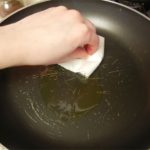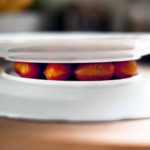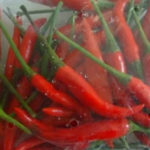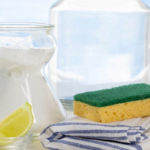A non-stick pan is made possible by the glossy Teflon coating. The adhesive part of the Teflon coating, however, is a harmful substance that makes many people hesitant to use non-stick pans. The adhesive portion is easily degraded at high temperatures during cooking, creating harmful substances for health.
1. Immediately wash the pan after cooking without letting it cool
As a common habit, we often put the pan we just finished cooking into the sink and turn on the water. This is fine for other types of pans, but it is strongly discouraged for non-stick pans.
Because the pan is still hot, coming into contact with cold water will cause thermal shock, causing the pan to warp or peel off the non-stick coating.
If the pan is heavily soiled and difficult to clean, try soaking it in warm soapy water, but avoid soaking it all day or overnight.
2. Preheat the non-stick pan
With aluminum or cast iron pans, it is best to add oil to the pan after it has been preheated.
With non-stick pans, it is exactly the opposite. Add oil to the pan first before placing it on the heat. Leaving the pan empty on high heat, without any oil or food, will significantly shorten the lifespan of the pan.
Note: When cooking, use low to medium heat to protect the non-stick coating of the pan.
3. Use metal utensils to flip food
Metal is the number one enemy of non-stick pans. Even if the pan is made of thick pure aluminum or has multiple layers of non-stick coating, the non-stick layer can still peel off.
Avoid using metal spoons, forks, or spatulas to flip food or using knives to cut food directly in the pan. Instead, use utensils made of wood, silicon, or bamboo.

4. Misuse of pots and pans
• Food storage
We often have the habit of leaving cooked food in the pot or pan all day, for the convenience of reheating later.
The pot or pan is a utensil for cooking, not for storing food. Especially acidic foods like tomatoes, oranges, and lemons can reduce the durability of the equipment and affect the quality of the food.
• Grilling food
Grilling at high temperatures can damage the non-stick coating, causing it to peel off and reveal the adhesive layer that bonds the metal surface of the pan to the non-stick layer. It is best to use a pan specifically designed for frying when grilling.
If you want to grill on a non-stick pan, use low heat, do not leave the pan empty on the stove for too long, and avoid grilling with lean meats such as fish, shrimp, and vegetables.
• Cooking braised dishes
A large amount of salt, spices in braised dishes can affect the non-stick layer on the pan, causing the surface to be rough and damaging the non-stick coating. According to the recommendations of manufacturers, you should not add salt directly while using the pan.
According to Phap Luat va Ban Doc (Law and Reader)
Ten Strategies to Streamline Your Cooking Process
Are you a busy housewife looking for ways to save time in the kitchen? Did you know that flossing can also help you out? Check out these 10 tips to help you quickly and easily prepare delicious meals for your family. Learn how to peel garlic in 10 seconds and cut cherry tomatoes quickly for a healthy and tasty meal.
4 Strategies for Storing Chili for One Month
Do you want to enjoy the fresh, spicy flavor of chili peppers all month long? Look no further! This article provides tips and tricks for storing chili peppers so that they stay fresh and flavorful for up to a month. Learn how to best preserve your peppers and savor their zesty taste for weeks to come.
Discover the Quickest Way to Clean Your Fridge for Tet in Under 20 Minutes
As we approach Tet, preparations for the New Year can seem endless. From cleaning the house to sorting through cabinets, it can be a taxing process. But perhaps the most dreaded New Year chore is refrigerators. No need to fret, though – with these helpful tips, you’ll have a clean fridge in no time – just 20 minutes!





































